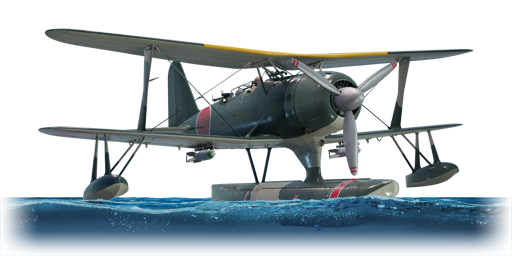

Aviation
F1M2
I
Rank
AB
1.0
RB
1.0
SB
1.0
Battle rating
Japan
Game nation
Bomber
Main role
2,900

Research
700

Purchase
General information
The F1M, designated as Type 0 Observation Plane (零式水上観測機), replaced the E8N2 and served as a scout for battleships. It also performed various other tasks, such as escorting convoys, bombing targets, maritime patrol, rescue, transport, and anti-shipping strike.
The F1M2 has been in the game since the start of the Open Beta Test prior to Update 1.27. Although it is classified as a bomber, it only carries 2 x 60 kg bombs and has a high-altitude bomber spawn, which limits its effectiveness in that role. The best approach is to spawn at the airfield and compete with fellow biplanes as a fighter, a role the F1M2 performs better at, surprising unsuspecting enemies with its versatility.
Camouflages
Flight performance
Max speed
at 4,000 m
412388427397 km/h
Rate of Climb
13.61116.911 m/s
Turn time
1718.416.317.8 s
Max altitude
9,200 m
Takeoff Run
300 m
Landing
flaps
flaps
Take-off
flaps
flaps
Combat
flaps
flaps
Air
brake
brake
Gear
control
control
General characteristics
Crew
2 persons
Engine
Length
9.5 m
Wingspan
11 m
Wing Loading
88 kg/m²
Weight:
Base weight
2.182.242.122.23 t
Fuel in main tanks
0.35 t (1h 29m)
Limits:
Max Speed Limit (IAS)
550 km/h
Mach Number Limit
0.45 M
G limit
≈ -6/10 G
Flap Speed Limit (IAS)
L / T / C
240 / 337 / 356 km/h
Offensive armament
2 × 7.7 mm Type 97 machine gun
Ammunition
1,000 rounds
Fire rate
900 shots/min
One-second Burst Mass
0.15 kg
| Belt | Belt filling | Armor penetration (mm) at a distance: | |||||
|---|---|---|---|---|---|---|---|
| 10 m | 100 m | 500 m | 1000 m | 1500 m | 2000 m | ||
| T/AP/IAI/AP/I | 13 | 12 | 7 | 3 | 2 | 0 | |
| T/AP/IAI/AP | 13 | 12 | 7 | 3 | 2 | 0 | |
| T/T/T/AP | 13 | 12 | 7 | 3 | 2 | 0 | |
| I/AP/AP/AP/IAI | 13 | 12 | 7 | 3 | 2 | 0 | |
Defensive armament
Turret — 7.7 mm Type 92 machine gun
Ammunition
582 rounds
Fire rate
700 shots/min
One-second Burst Mass
0.13 kg
| Belt | Belt filling | Armor penetration (mm) at a distance: | |||||
|---|---|---|---|---|---|---|---|
| 10 m | 100 m | 500 m | 1000 m | 1500 m | 2000 m | ||
| T/AP/Ball/AP/I/IAI | 13 | 12 | 7 | 3 | 2 | 0 | |
| T/AP/AP/IAI/AP | 13 | 12 | 7 | 3 | 2 | 0 | |
| AP/T | 13 | 12 | 7 | 3 | 2 | 0 | |
Suspended armament
Setup 1
2 × 60 kg Navy Type 97 Number 6 ground bomb
Economy
Repair cost
Basic → Reference
AB
97 → 131 

RB
139 → 188 

SB
160 → 216 

Crew training
200 

Experts
1,000 

Aces
20 

Research Aces
96,000 

Reward multiplier
AB / RB / SB
20 / 30 / 60 % 

100 % 

Total cost of modifications
2,970 

890 

Talisman cost
190 

Research order:
Flight performance | |
|---|---|
Survivability |
|---|
Weaponry | |
|---|---|
Rating by players
You must play more than 3 battles for the last week and more than 10 battles in a vehicle to rate it.
Like:
10
Flight performance:
Not enough ratings
Survivability:
Not enough ratings
Aerial combat:
Not enough ratings
Ground attack:
Not enough ratings
Balance:
Not enough ratings
Tips & Tricks
This space is currently empty
Do you know any interesting vehicle features?
Loading...
No articles about this vehicle yet
Become the first author and get rewards!
Write a guide, tell about interesting historical facts, make a tutorial or simply an interesting post.
No more content